#seattle marijuana stores
Text
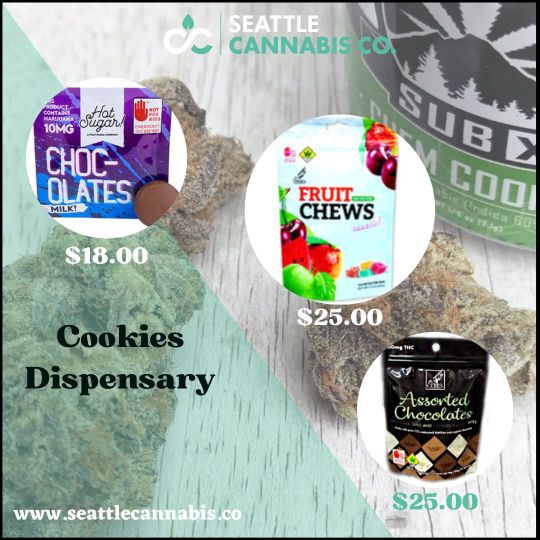
Find The Best Cookies Dispensary in Seattle – Seattle Cannabis
Cookies Dispensary offers a large selection of joints, edibles, concentrates, topical and cannabis smoking supplies. If you want to get them, visit the Seattle Cannabis Co. Recreational Dispensary for the largest selection of these products. Order them now! Visit www.seattlecannabis.co & call us on (206) 420-1042.
#Marijuana in Seattle#Seattle Marijuana Dispensary#Seattle Marijuana Store#Marijuana near Me#Cannabis Dispensary near Seattle#seattle marijuana stores#seattle marijuana store#cookies dispensary#cookies marijuana
2 notes
·
View notes
Text
I Love Washington
Marijuana Stores. All colors. All flavors. Storefronts everywhere. It's very freeing to have access to these things. It's no small thing that this state is one of few. I don't take these so called small things for granted. It's worth all the money, and in that respect, there are amazing deals everywhere. Seattle is prohibitively expensive. Insanely so. But this single asset is very freeing.
3 notes
·
View notes
Text
Discovering the World of CBD in Seattle: A Comprehensive Guide
Understanding CBD
Cannabidiol (CBD) is a natural compound found in the hemp plant. Unlike its cousin tetrahydrocannabinol (THC), CBD does not produce a psychoactive effect, making it a popular choice for those seeking relief from pain, anxiety, and other ailments without the "high" associated with marijuana. CBD is available in various forms, including oils, edibles, topicals, and capsules, catering to diverse preferences and needs.
The Benefits of CBD
CBD has garnered attention for its potential health benefits, backed by both anecdotal evidence and scientific studies. Some of the primary benefits include:
Pain Relief: CBD is known for its analgesic properties, offering relief from chronic pain conditions such as arthritis, migraines, and fibromyalgia.
Anxiety and Stress Reduction: Many users report a calming effect, Cbd Seattle making CBD a popular choice for managing anxiety, stress, and even depression.
Improved Sleep: CBD may help improve sleep quality and duration, providing a natural alternative to prescription sleep aids.
Anti-Inflammatory Properties: CBD's anti-inflammatory effects can benefit those with inflammatory conditions like acne, psoriasis, and irritable bowel syndrome.
Neuroprotective Benefits: Emerging research suggests that CBD may support brain health and protect against neurological disorders.
CBD Shops in Seattle
Seattle is home to numerous CBD shops, each offering a unique selection of products. Here are some top spots to explore:
The Novel Tree: Known for its knowledgeable staff and wide range of products, The Novel Tree offers high-quality CBD oils, edibles, and topicals. Their commitment to education ensures customers find the right products for their needs.

CBD of Seattle: This dedicated CBD store features a curated selection of tinctures, gummies, creams, and pet products. Their focus on quality and customer service has made them a trusted name in the local CBD community.
American Mary: While primarily a cannabis dispensary, American Mary also offers an extensive range of CBD products. Their convenient location and knowledgeable staff make it a popular choice for both locals and tourists.
The Green Door: With a welcoming atmosphere and a diverse selection of CBD items, The Green Door is a favorite among Seattle residents. They offer everything from CBD-infused beverages to topicals, catering to all preferences.
CBD in Seattle's Wellness Scene
Beyond dedicated CBD shops, many wellness centers and spas in Seattle incorporate CBD into their services. From CBD-infused massages to yoga classes that enhance relaxation, Seattle Marijuana the city's wellness scene embraces the holistic benefits of CBD. Popular spots include:
Ananya Spa Seattle: This luxurious spa offers CBD-enhanced massages and facials, providing a unique and relaxing experience.
Urban Yoga Spa: Known for its innovative approach to wellness, Urban Yoga Spa offers CBD-infused yoga sessions, promoting enhanced relaxation and mindfulness.
Navigating the Legal Landscape
In Washington State, hemp-derived CBD products are legal, provided they contain less than 0.3% THC. This means that CBD products are widely accessible in Seattle, both in physical stores and online. However, it's essential to purchase from reputable sources to ensure product quality and safety.
0 notes
Text
https://mediamonarchy.com/wp-content/uploads/2024/04/20240418_MorningMonarchy.mp3
Download MP3
Rust sentencing, false god particles and the tickle giggle + this day in history w/directing NXIVM and our song of the day by Michelle David & The True-tones on your #MorningMonarchy for April 18, 2024.
Notes/Links:
Image: Please keep your arms and legs inside the ride until the gnar has come to a complete stop
https://mediamonarchy.com/wp-content/uploads/2024/04/rollercoaster_gnar_ride.png
Sierra Leone declares emergency over drug kush – made from human bones; Psychoactive drug kush has prompted a wave of deaths, mental health issues and the digging up of graves.
https://www.bbc.com/news/world-africa-68742694
Rats are ‘all high’ on marijuana stored in infested New Orleans police evidence room
https://www.nbcnews.com/news/us-news/rats-are-high-marijuana-stored-infested-new-Orleans-police-evidence-ro-rcna143249
Video: Rats infest New Orleans Police Headquarters, eat marijuana in evidence (Audio)
https://www.youtube.com/watch?v=vkbP1tYENQY
New York faces major rat urine problem
https://www.rt.com/news/595847-new-york-rats-leptospirosis-rise/
Let Them Eat Snake – Climate farming dreams: A nightmare for diners.
https://johnklar.substack.com/p/let-them-eat-snake
Video: @AnarchistAlchemist’s Corby Bugz Beatz (Audio)
https://cdn.discordapp.com/attachments/379774652719038466/1229852536182411306/VID_20240416_125207383.mp42.mp4?ex=6631306e&is=661ebb6e&hm=ee9e864069ea24c5317642fceddd620a7ce118a8370ea75dbe594b02ce542fa7&
Bird mimicking police siren confuses officers
https://www.bbc.co.uk/news/uk-england-oxfordshire-68785461
Gordon Ramsay’s pub has a squatter problem: far-left collective calling themselves Camden Art Cafe, have turned the property into an “autonomous” zone, akin to Seattle’s CHAZ and George Floyd Square in Minnesota
https://www.mirror.co.uk/3am/celebrity-news/gordon-ramsays-nightmare-squatters-take-32580460
Man upset over guacamole amount shoots Michigan Chipotle employee
https://www.fox2detroit.com/news/man-upset-over-guacamole-amount-shoots-michigan-chipotle-employee-police-say
O.J. Simpson’s Will Executor Says ‘Fred Goldman’s Claim Will Be Accepted’ Days After Saying He’d Get ‘Zero’: Report; O.J. Simpson’s final will was filed in Clark County, Nev., on April 12, two days after his death at 76
https://people.com/oj-simpson-will-fred-goldman-claim-accepted-lawyer-says-8634390
Ron Goldman
https://en.wikipedia.org/wiki/Ron_Goldman
Homeless man steals former FDNY fireboat, can’t start engine
https://archive.is/ses2b
“Rust” armorer Hannah Gutierrez-Reed sentenced to 18 months in prison over deadly 2021 shooting
https://www.cbsnews.com/news/hannah-gutierrez-reed-rust-armorer-shooting-sentence-hearing-involuntary-manslaughter-halyna-hutchins-alec-baldwin-new-mexico/
Video: “Rust” armorer Hannah Gutierrez-Reed sentenced to 18 months in prison (Audio)
https://www.youtube.com/watch?v=6WoFBElYsdg
Image: @Hybrid’s Cover Art – The Woke Ranger’s ‘Cage of Rust’
https://mediamonarchy.com/wp-content/uploads/2024/04/20240418_MorningMonarchy.jpg
Image: Previous album – The Woke Ranger’s ‘Cocaine Country’ (Feb. 22, 2024)
https://mediamonarchy.com/20240222morningmonarchy/
‘Neo-Nazi Satanist cannibals’ who lured woman to her death as a human sacrifice then ‘roasted and ate another victim’s flesh and ribs’ are jailed in Russia
https://www.dailymail.co.uk/news/article-13289595/Neo-Nazi-Satanist-cannibals-lured-woman-death-human-sacrifice-roasted-ate-victims-flesh-ribs-jailed-Russia.html
Alabama harvested the organs of inmates without consent, families say; A long-standing agreement between the Department of Corrections and University of Alabama at Birmingham gives the commissioner authority to permit an autopsy, including the “removal of organs and tissues.”
https://archive.is/fa5Wj
Gabriel Holt: Tributes to Wales rugby league player who has died suddenly aged 21
https://news.sky.com/story/gabriel-holt-tributes-to-wales-rugby-league-player-who-h...

View On WordPress
#alternative news#holy hexes#media monarchy#Michelle David & The True-tones#Morning Monarchy#mp3#podcast#Songs Of The Day#This Day In History
1 note
·
View note
Text
6/20-26: finding Pride in many things (cooking for friends, hosting a farewell party, and witnessing naked cyclists, among others)
39th WEEK, JUN 20-26, 2016.
(a.k.a the very very last one.)
-
Wow. Okay.
Need to breathe it in for a sec.
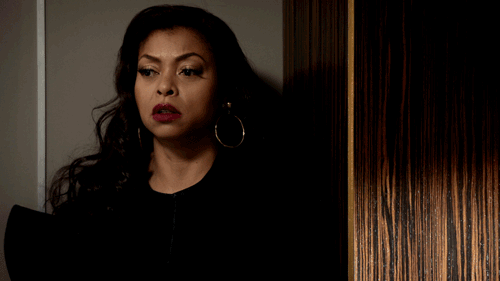
Alright. The last week of 9 months.
A lot has happened, because of course I willed myself to have a lot happening.
Monday, June 20:
I took this day to do a last good tour of downtown. Did some last-minute shopping, took a fair amount of photographs (which I lost along due to the broken hard drive), and overall feasted my eyes with the wonder of downtown Seattle with its high-rises and hills and valleys and blooming trees lining the wide curb and the pigeons by Westlake Center and the innocence of Pike Place Market and the breeze along the waterfront and the Gum Wall and the hustle and the bustle and everything else in between.
(you know what I will not miss? The weed smell. It’s so Seattle, but at the same time, I can live in a version of downtown Seattle with no marijuana scent constantly hanging in the atmosphere of alleyways and city buses)
Maybe in the future I could be living in another big city or some other beautiful places, but I always know that nothing beats downtown Seattle in all its grandiosity and color. Nada.
-
Tuesday, June 21:
Part of the downtown tour agenda was shopping at Chinatown for ingredients for what I was about to do on Tuesday. Some of my friends from Rainier Beach (Mary, Rebecca, Emily, Kira) were coming to visit after school (they were juniors and so they still had school), and I planned to make some Indo food! The choice fell to the classics ketoprak (for its ease) and martabak manis (as my propaganda to promote chocolate-and-cheese combo to foreigners—don’t @ me).
I think I initially planned to make gado-gado but some veggies required in gado-gado were scarcely available even in Seattle’s Chinatown, so I settled down for something which ingredients are more readily available: ketoprak. As for martabak manis, I found a quick mix for that thing in the Asian market HAHAHA all I needed to do was wet the drys, pour them into the pan, and wait.
It turned out great—for an impossible-to-screw-up recipe, but I’m still proud of myself. As long as the guests were happy.
I’d see these girls again the next day on Wednesday, June 22, when we had a sleepover at Rebecca’s. Talk about sleeping over on a school night. But it was worth every second of it. I remembered we took a trip ‘round the city doing stuff, and we got back late at night, all of us piled into Rebecca’s bed straight away, too tired to think or do anything else.
Thursday and Friday I went to school to take care of some stuff. Friday, June 24, was the last day of school for the year at Rainier Beach HS (and for me, ever), and at the evening I had my own goodbye party hosted at home. I invited everyone from dear friends at AFS Seattle chapter and at school, former host families, to the adults I’ve gotten to know along the way, like Laura and Imad and other people.
Here's the funny thing: I couldn’t even eat for most of my own goodbye party. The party started at around 6 or 7 I reckoned, and sunset/iftar was not until 9. So what I had been doing—and Eric had been assisting me in doing—was once in a while grabbing a snack I wanted to eat and just sort of store them in a corner in case they ran out before 9.
Imagine roasting marshmallows and making s’mores but not being able to eat them straight away.
It was a fun one rather than a sad one, though, to be honest. Maybe because we weren’t yet registering the fact that a farewell is truly coming, and plus I still have one last chance for good-bye with my fellow exchange students.
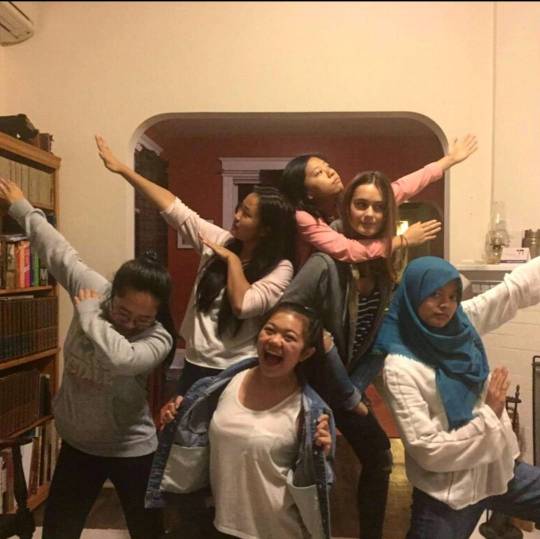

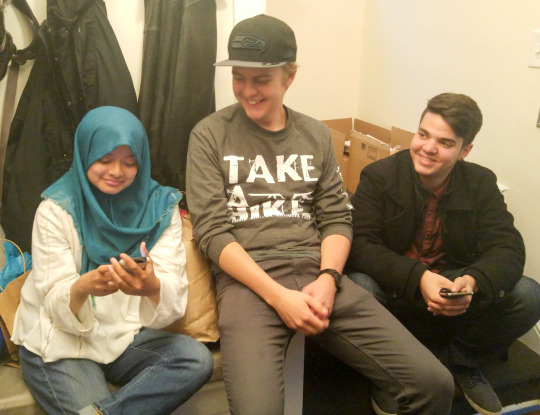
Like a normal person trying to squeeze out as many agendas as she can in her last days of living, after the goodbye party I went to Hinaho’s for a sleep over with fellow AFSers. I had been to Hinaho’s before, and I love her house and her neighborhood and her host family is just the nicest people, so I was excited to be back and we had a great time. We all camped in her living room and watched movies (one I remembered was The Divergent Series: Allegiant Part 1) until all of us just dozed off and the TV was left on.
(another personal, trivial moment I remembered was me waking up at the wee hours of the night in my sleeping bag, being reminded that it was time for suhoor, so I lazily grabbed one or two energy bars from my pack.)
(not that it’s a good advice to give, but during this time of the year I realized I could survive a fasting day without suhoor, as I almost never miss one my entire life until this year—and an 18-hour fasting day at that. So I figured, at least these energy bars would be enough rather than nothing at all.)
(and I don’t know, maybe being occupied in activities that make the time fly by also helps with fasting because you’re too busy doing these things you’re not reminded of hunger and thirst—as long as it is not a physically-demanding activity. It was pretty much like you’re too focused on doing something that you just forget to eat and accidentally skip meals. Another thing is that Seattle—even maybe the US in general—just did not have that Ramadan vibes, and that’s okay, because in Indo, I am always reminded of Ramadan because almost everyone is fasting and Ramadan being the festivity season that companies take so much advantage of as their marketing strategies. Sure, the lack of Ramadan vibes was saddening—in a way that I was just living my days without eating and drinking and getting angry without the semi-obligatory crowded late afternoon markets full of scrumptious snacks and gluttonous congregation, and nightly two-hour long prayers with noises of kids running around playing cat-and-mouse in the mosque yard—but that’s okay too, because I already knew these things when I jumped in. All I was worried about was surviving 18-hour fasting days and turned out it was the least of my worries.)
Saturday, June 25, Karen took me for a walk around Capitol Hill and Volunteer Park.
I couldn’t believe it was my second-to-last day and I was still discovering new things—Volunteer Park, especially, being so close to our house and I couldn’t believe I never went there before.
The park, like most Seattle parks, was a beautiful one. It was vast, with a greenhouse and a lake and even a museum (Seattle Asian Art Museum, which we didn’t have the time to visit). Karen took me up the water tower, which had an observation deck that provided a view of the park and a portion of Seattle beyond it. By the lake was a sculpture that the park was famous for—originally titled “Black Sun” by Isamu Noguchi, and colloquially referred to as “The Doughnut” (reminds you a lot of the same case with Chicago’s “Cloud Gate”, huh?). From The Doughnut’s hole, you can spot the Space Needle with the lake in the foreground, as though the Needle rose from the waters.

The water tower (volunteerparktrust.org)
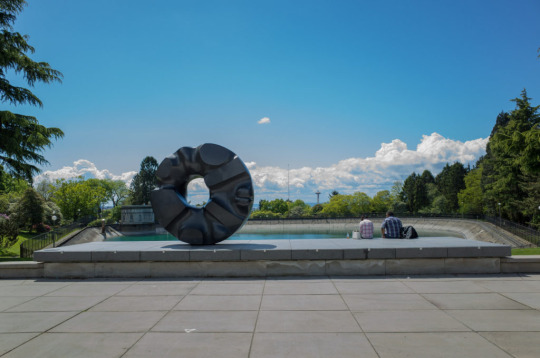
The "Black Sun" aka "The Doughnut" (volunteerparktrust.org)
-
Sunday, June 26: best day in Seattle ever.
No, not it being the last day in Seattle—that part was depressing. But at least I was ecstatic that I got to end the journey with a bang, by watching Seattle Pride Parade.
Add that to the list of things I would never ever ever get the chance to do in a million years had I not decided to jump into the exchange student bandwagon.
I forgot where I had heard of the Pride Parade from. Maybe Patricia and Amber. Maybe Karen, knowing my giddiness for festivals and public events to witness. At any rate, it was such luck that Pride Parade fell on that day, because if it were one day later, I wouldn’t have been able to attend and I would have missed one of the best experiences in my life.
So much coming from a mere spectator. But it truly was a thrilling experience.
Karen end Eric had stuff to do, so I hopped on to the bus downtown by myself (what else is new?) at around mid-morning, when the parade had just started. I was told that Patricia and Amber (along with Vera) would be there too (of course), so I planned on meeting up with them later on.
How was the parade?
Simply put, there were a lot of things.
There were of course big companies and brands with their employees dancing around carrying balloons with their brand on it, there were floats from big and local businesses, there were marching bands, there were local communities marching while carrying a long banner or letter balloons. Many floats have half-naked men dancing and having fun with themselves (from gay bars, mostly). There were people in just about any type of clothing and accessories dancing along the blasting music and giving free high-fives or even hugs to the spectators.
It truly was a day where people get to be free and themselves when 364 other days they don’t get to.
There were drag queens walking along with their stellar outfit and makeup, which amazed me the most because I had never seen such dedicated drag queens before. The image I have of drag queens are the ones available back in the home country—you slap a wig and dress and chest stuffing and you’re good to go to, either for busking around street food stalls for change or for other nightly services. Not saying that Indo drag queens are bad, but objectively the drag queen culture there is not as dedicated as it is in the US, with the addition that the US drag culture is well-facilitated, what with the bars and shows and RuPaul’s Drag Race and overall interest from the audience.
Suffice it to say, the drag queen industry was a flourish. And I was there to only experience the gist of it in the parade.
If I had posted this sooner, I would still have the chance to post the pictures, but since most of them are gone with the hard drive, here are some I vetted from my Instagram:

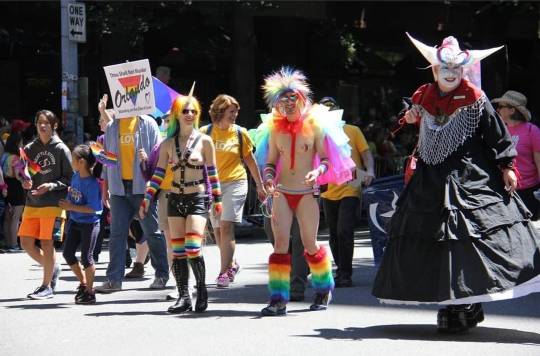
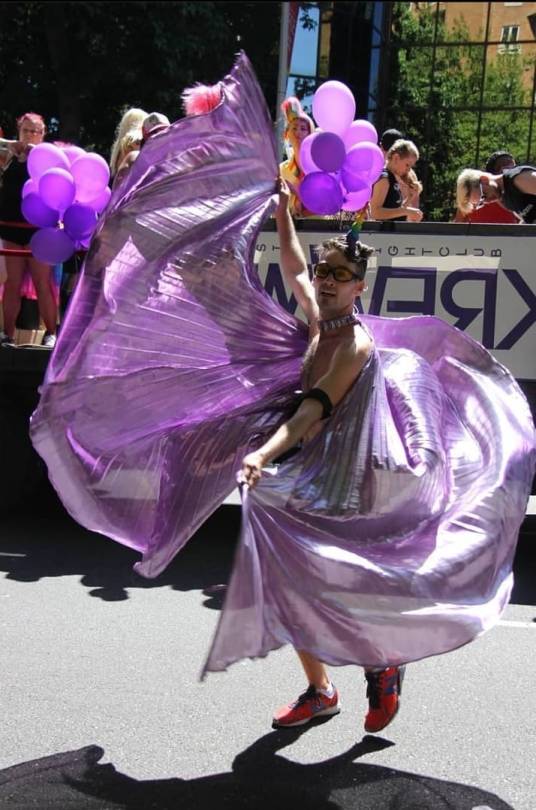
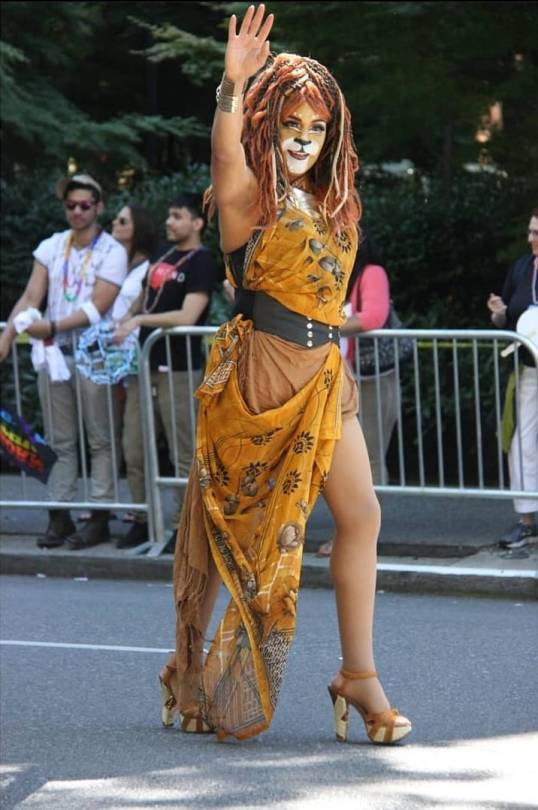

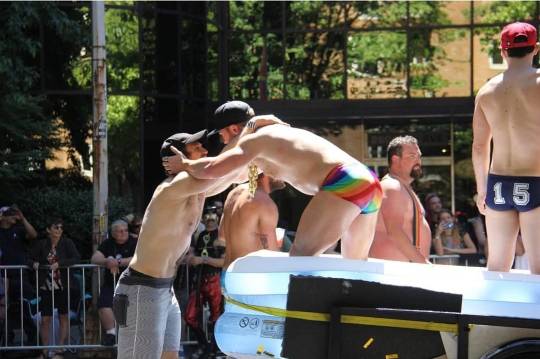
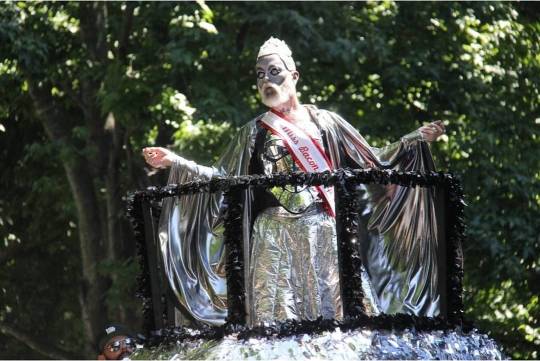
I met Patricia, Amber, and Vera in Seattle Center area, by the Space Needle. I hung out with them as they had lunch, me enjoying my last moments of playing with sweet little Vera while she still knew me in her toddler life.

After lunch, we went back to the streets. Vera looked excited at seeing these many things the parade had to offer (I remembered she was particularly excited when a group of people wearing leather and dog-like accessories—I later learned from Patricia that it was a community for enthusiasts of sub-dom puppy play and the sorts (CMIIW for the description)—and she went “pups!” so cute and blissful of her).
After a while, Vera no longer looked excited, which means she’s all drained. Patricia and Amber said goodbye while I stayed in the streets, still full of energy and not wanting to miss any of the event I would most likely get only once in this lifetime.
I walked along the streets from Seattle Center back to downtown, trying to find a good viewing spot. The floats were still floating, the dancers dancing, even the mayor was there too. At some point, I saw a group of people in the distance that I thought I had missed and would not see in this parade, but then again, on second thought, it totally should be in the parade.
Men and women and all the genders in between, cheering and cycling through the streets with their biggest smiles and hands waving.
They were in on it so good, I didn’t even notice until they got closer that all that was on them was body paint.
Naked cyclists!
My remorse of missing out on the Summer Solstice Parade instantly evaporated. Apparently I’m just that easy lol.
Not long after the cyclists, the parade slowed down to a close, the last show was people carrying a big-ass pride flag as wide as the street itself, facing the sky. The sun shining through the flag turned the asphalt below it into wonderful shades of rainbow colors.

(southseattleemerald.com)
Again, to say that this was an exciting experience was an understatement. This was the thing I had been looking forward to, though I came in with no expectations. Personally admitting, the conservative corner of me was astonished upon seeing what the parade had to offer me, but as the day went by, I ended up enjoying every second of it. I was basking in overstimulation—the clear sky, the hot weather, the bright pride colors, the big floats, the loud music, a new thing to witness every 5 minutes, the sea of excitement radiating from both the spectators and the contributors, and most importantly, the overwhelming amount of happiness, freedom, and, well,
pride.
It may not be my freedom and pride, but seeing them celebrating it made me as jubilant as they were. Happiness is truly infectious.
The other thing I’m most grateful about from this experience is to be able to witness first-hand what the word ‘pride’ in this context really means. Sure, in this era, we can still educate ourselves on the matter—there are thousands of sources and internet friends you can find that can give you all the information you need—but honestly, the Internet can only do so much, especially if the surroundings you’re in do not support or facilitate the issue. I feel like if I hadn’t gotten out, I wouldn’t have been able to empathize this much. I did understand the existence of the issue and that there are struggles on it, but being in Downtown Seattle on June 26, 2016 was what really woke me up.
After all, it kind of boils down to one simple matter: if any goals you have in this life, whatever they are, lead to you being happy and living in a world that is also happy, then why can’t you let other people do the same?
-NS
1 note
·
View note
Link
0 notes
Text
How much is a quarter of marijuana

What is a fourth of weed and how much is a fourth of weed in grams? A fourth of weed alludes to a fourth of an ounce of cannabis blossom. An ounce is a little north of 28 grams, so a fourth of an ounce is 7 grams.
Certain individuals could get befuddled between how much is in a fourth of weed versus a quarter pound of weed. This mix-up could be an exorbitant one in the event that you unintentionally purchase a quarter pound of weed rather than a quarter ounce. All things considered, a fourth of weed is 7 grams of weed, or two eighths of an ounce. A quarter pound of weed is 4 ounces, or 113 grams of pot.
The cost for a fourth of pot differs from one state to another, yet it likewise shifts from one city to another.
As indicated by Silvery Composes, the public typical expense for a fourth of weed is around $68, which is really $6 less expensive than the value it was last year, which went for a public normal of $74.
To begin with, for any novices in the weed game, here's a simple manual for the marijuana language:
Eighth of weed = 3.5 grams
Quarter of weed = 2 eighths = 7 grams
A big part of weed = 2 quarters = 4 eighths = 14 grams
Ounce of weed = 2 parts = 4 quarters = 8 eighths = 28 grams
Now that you comprehend the rudiments we should examine the costs for a fourth of weed all through the country. The cost you're paying for a fourth of weed relies upon where you're found, the season, and a few different variables.
The cost you'd pay for a fourth of weed likewise relies upon the strain and the quality. Famous strains like Blue Dream could run your pockets somewhat more profound than in essence; less popular strains Chocolate Cheesecake. This likewise relies upon accessibility (supply + request) and where it's developed.
Finding the most sensible and reasonable costs on specific kinds of pot or other marijuana items can be testing, yet on account of Magnificent Composes for accomplishing the snort work, we're ready to share how much a fourth of weed is in nine famous urban communities all through the US.
We've likewise featured arrangements around every city to assist you with getting a value for your money.
The amount Is A Fourth Of Weed In Denver, CO

In Denver, a fourth of weed will sell for around $54 and as low as $40 for sporting use. Bargains in and out of town include:
Stash House: $40
Kaya Marijuana: $40
The Pig N Whistle: $41
The amount Is A Fourth Of Weed In Seattle, WA
In Seattle, a fourth of weed will sell for around $57 and as low as $52 for sporting use. Bargains in and out of town include:
Herban Legends: $52
Pot City: $52
The amount Is A Fourth Of Weed In Portland, OR
In Portland, a fourth of weed will sell for around $53 and as low as
$42 for sporting use. Bargains in and out of town include:
Stoney As it were: $42
Floyd's Fine Marijuana: $45
Oregon Developed: $47
The amount Is A Fourth Of Weed In Los Angeles, CA
In Los Angeles, a fourth of weed will sell for around $65 and as low as $44 for sporting use. Bargains in and out of town include:
The Ceramics: $44
The Alleviation Aggregate: $55
What amount does a fourth of weed cost?
Like an eighth of weed, quarters are a typical estimation sold in both lawful and unlawful business sectors around the US. A fourth of weed can run you somewhere in the range of $20 during the collect season at dispensaries in Oregon, to well more than $100 for a quarter ounce of planner pot bought from a store dispensary in Los Angeles. The cost of a fourth of weed fluctuates in light of area, pot quality, and, surprisingly, the season. For instance, open air financially developed weed is frequently sold at a markdown in the pre-winter and winter in regions where it is developed on the grounds that ranchers flood dispensaries with modest marijuana blossoms. Individuals here can purchase excellent quarters of weed for a negligible portion of the value they would ordinarily pay. Later in the spring and the mid year, costs might rise because of a reduction in supply.
How long does a fourth of weed endure?
Since it has become so undeniably obvious what a fourth of weed is, we should sort out how long a fourth of weed endures. A fourth of weed is normally enough for five to seven dulls or many dishes and joints. For certain individuals a fourth of weed could last them long stretches of microdosing. Someone else could utilise a quarter ounce of weed to make one bunch of brownies. The response to "how long does a fourth of weed keep going?" changes in light of how you are consuming it. For instance, in the event that you are utilising a line, a day to day client could make a fourth of weed last week. Be that as it may, on the off chance that you are moving enormous joints for yourself, it could endure just three days. How long a fourth of weed endures depends upon different elements like your portion, how regularly you use marijuana, and whether you are partaking in weed alone or with companions. The most ideal way to make a fourth of weed last longer is to utilise the Mutually application to track down the base viable portion of pot for your objectives.
How could I store my quarter ounce of weed?
A quarter ounce of weed is a great deal of pot. As we referenced over, a fourth of weed endures certain individuals for quite some time. Considering that you may be clutching your quarter ounce of weed significantly longer than a pre-roll or a parcel of edibles, how ought you store your quarter ounce of weed?
You need to try not to dry out your quarter ounce. You likewise don't maintain that it should get damp or, more than likely it could get rotten as we talked about in Does Weed Turn sour? The most ideal way to store a quarter ounce of weed is to put it in a bricklayer container with a dampness pack. The stickiness pack will keep up with legitimate dampness levels so your pot will remain in top condition. Moreover, you will need to store it in a dull region that is kept at room temperature.
How to ensure you are genuinely getting a quarter ounce of weed?
A quarter is a lot of marijuana, so how would you ensure you are really getting a quarter ounce of pot? You could ponder, "the number of buds that ought to be in a fourth of an ounce?" As we examined over, the quantity of buds shifts essentially in that a fourth of weed could be a solitary thick bud or it very well may be many little buds. The best way to be sure you are getting a quarter ounce of weed is to weigh it yourself. Any modest gram scale or kitchen scale will get the job done for this reason.
Would you like to purchase a quarter ounce of weed yet you don't realise which weed strain to pick? Look at our article Why Mutually Is Superior to a Strain Locater to figure out how to find the best marijuana strains for your wellbeing objectives.
Track down top of the line items for your objectives
Mutually is a pot disclosure application that makes it simple to find and coordinate with the best pot and CBD items for your objectives. Your matches are determined from the genuine item evaluations and encounters of countless individuals utilising the Together application.
On the off chance that you're prepared to find new items and arrive at your objectives, download the Mutually application today on the Application Store or Google Play, or investigate your matches on the Together site.
Is it true or not that you are interested in each other?
Whether you need to further develop rest, ease day to day pressure, or simply unwind and revive, Mutually can assist you with arriving at your objectives with marijuana.
Mutually, coordinate with first class items, and fabricate arrangements of your top picks to save, share, and bring to your neighbourhood dispensary to assist with directing your shopping experience.
Together additionally assists you with following your weed encounters through reflections that assist you with grasping what's working, and so forth. Truth be told, the nature of your eating routine, the amount you dozed, who you're with, and the hour of day are only a portion of the variables that can influence your encounters.
So on the off chance that you're prepared to partake in your ideal marijuana experience, download the Mutually application today on the Application Store or Google Play, or investigate your matches on the Together site. Disclosure is standing by.
1 note
·
View note
Text
The Best Recreational Cannabis in Seattle – Seattle Cannabis
Recreational Cannabis in Seattle offers its customers a variety of products and benefits. There are several other categories to choose from, including flower and raw marijuana. Pre coils, vapors, food, drinks, tinctures, topical and more. We give everyone access to their needs at an affordable price! To know the details contact us www.seattlecannabis.co and call us on (206) 420-1042.
#Recreational Cannabis in Seattle#cookies dispensary#marijuana near me#seattle marijuana stores#medical marijuana dispensary#seattle marijuana store#seattle marijuana dispensary#marijuana in seattle#cookies marijuana#best seattle marijuana dispensary#cannabis dispensary near seattle
1 note
·
View note
Text
Hemp Personal Shoulder Bag Organizer Sweatshop-free
Please share your comments, questions and suggestions relating to your experience on Top10ERP.org. Price quotes are offered to enterprises in the USA and Canada only. Download the free “New Cannabis Ventures” app on the iOS App Store or Google Play and get real-time push notifications straight to your telephone on the newest breaking information and exclusives published. The largest and most comprehensive premium subscription service for hashish merchants and investors since 2013. Elevated Signals serves small, craft producers, mid-size producers and enormous producers. Some of the company’s clients include Pure Sunfarms, Rubicon Organics, Tantalus Labs, Decibel and Habitat Craft Cannabis.
We imagine that a fantastic product can't exist without nice customer service. Our specialists are always obtainable that can help you and normally reply within 5 minutes. Cannabis distributors have especially extensive traceability requirements for their merchandise. Some regulations mandate that hashish companies observe batches from “seed to sale”, from every plant seed to every package deal offered to a buyer. Package and lot sizes are outlined by the tracking system implemented by the regional company or companies overseeing hashish product gross sales within a given space.
Seattle Cannabis Exchange is an working system on your cannabis business. KayaPush, an all-in-one platform, permits you to develop your dispensary and simplify payroll, HR, and workforce administration. KayaPush integrates with the most popular dispensary POS techniques to offer an end-to-end solution. For now, Elevated Signals will concentrate on rising organically, and it will remain targeted on production. The company has plenty of room to go deeper in serving cultivation and manufacturing operations, according to Singh. At its inception, Elevated Signals was meant to give attention to precision agriculture with the use of wi-fi sensors, integrating with seed to sale software developed by different companies.
The chemical composition will look considerably totally different relying on how one selects the pattern. So it’s important to be cognizant of what and the way biomass testing is performed, and infrequently a single pattern isn’t the reply. When these learnings are utilized at manufacturing scale, the framework developed by way of DoE methodology supplies a information for creating constant merchandise, but additionally to higher sage x3 hemp manage and rectify issues that will come up. With specific goals in mind, processors can then determine what data they want to capture and analyze. These days, shoppers regularly use their smartphones to go looking the web and make online purchases. Hence, your eCommerce website must perform properly not simply on desktops but mobile gadgets as well.
As VP of Business Development for 3SI, Carlos Casas works to connect cannabis companies with this tech to protect their assets and workers. “According to a Forbes report from July 2020, an estimated 70% of cannabis businesses are cash-based. METRC and Bio Track are the 2 major seed-to-sale monitoring techniques used all through sage x3 hemp the United States. Most states have adopted using one or the other and few have implemented their very own manual monitoring. MobiusPay, Inc. is a U.S.-based global monetary companies organization that is committed to empowering people and companies.
In this time of progress, many hashish firms are grappling with complexity, unique operational wants, regulatory mandates and efficiency issues. Businesses understand they need the proper suite of enterprise useful resource planning instruments to address those challenges. A nearer look at those needs reveals that Sage X3 for the cannabis industry is the right ERP resolution. Simple, highly effective point-of-sale and monitoring system for recreational and medical Marijuana institutions. Plans beginning at $50/month Easy-to-use level of sale and stock monitoring system for farms and medical dispensaries. Sales, compliance, and tax reporting for medical and recreational dispensaries.
Data and analytics strategically to measure the health of their enterprise. Many cannabis retailers fail as a outcome of they don’t monitor crucial dispensary metrics or make avoidable mistakes. Finally, it’s essential to make certain that each location has access to its accounts to process its sales and deposits without having to go through a central office or proprietor each time there’s a difficulty. As you all know, competition was stiff for funding prior to 2022 however with the current financial system and rising interest rates, capital is much more durable to acquire right now.
If you’ve seen that your outdated technology slows you down, Sage Intacct could be the reply, and SC&H Group’s Accounting Solutions team is the best business associate to choose. Distribution software program, such as enterprise useful resource planning products, are among the most dear for the rising cannabis distribution subject. Here’s a closer sage x3 hemp have a glance at what hashish distributors do and how Sage X3 helps. Craig Napoli has been promoted from regional account manager to director of specialty merchandise at City of Industry, CA’s AIDP, Inc.. Mr. Napoli, who has been with AIDP for over five years, shall be answerable for overseeing sales in the Utah area, and might be project manager for all new specialty ingredients.
As far as we know, there is not any obligation on products entering Canada which are made in USA or the EU, which all of our merchandise are. Note that there are restrictions on some products, and a few merchandise cannot be shipped to international destinations. Dress jackets, lined gown pants, lined dresses and gowns, lined winter jackets are NOT mechanically cleanable or dryable. This is as a result of the outer cloth and the liner may shrink at different rates.
0 notes
Text
Exploring the Cookie Brand Weed: A Delicious Journey into Cannabis Culture
Origin and Legacy
Founded by Berner and his partners in San Francisco, Cookie gained prominence for its commitment to excellence and innovation in cannabis cultivation. What started as a passion project soon blossomed into a global phenomenon, attracting a loyal following of enthusiasts seeking top-tier marijuana experiences.
Signature Strains
Cookie brand weed is celebrated for its diverse and potent strains, each with its own unique characteristics and effects. Among the most revered is Girl Scout Cookies (GSC), a hybrid known for its euphoric high and sweet, earthy flavor profile. Cookie Brand Weed Another standout is Gelato, prized for its creamy texture and relaxing yet uplifting effects. These strains exemplify Cookie's dedication to crafting cannabis that not only delivers exceptional highs but also tantalizes the palate.
Cultural Impact
Beyond its product offerings, Cookie has left an indelible mark on cannabis culture. Its distinctive logo and packaging have become iconic symbols, instantly recognizable among enthusiasts. Cookie's approach to branding has set a new standard in the industry, blending streetwear aesthetics with high-end cannabis products.
Community and Advocacy
Cookie brand weed isn't just about consumption; it's also about community. Through events, collaborations, and social media engagement, Cookie fosters a vibrant community of like-minded individuals who share a passion for cannabis culture. Moreover, Cookie has been a vocal advocate for cannabis legalization and social equity, using its platform to push for positive change within the industry.
Quality Control and Innovation
Central to Cookie's success is its rigorous commitment to quality control and innovation. From seed to sale, each batch of Cookie brand weed undergoes meticulous testing to ensure purity, potency, and consistency. This dedication to excellence has earned Cookie a reputation as a trusted purveyor of premium cannabis products.
The Future of Cookie Brand Weed
As the cannabis industry continues to evolve, Cookie remains at the forefront of innovation and trends. With new strains and products constantly in development, Seattle Pot Store Cookie brand weed promises to delight aficionados and newcomers alike with its unwavering commitment to quality and creativity.

0 notes
Photo

Welcome to Seattlecannabis Co, which stocks some of Washington's best cannabis, so you'll find something to enjoy regardless of your budget. It’s our sole mission to offer clean and sustainable product to our consumers, while also providing the best quality Marijuana. Seattlecannabis Co is the only Marijuana Dispensary in Seattle which has access to the highest quality cannabis for the best prices. We have over 50 strains of premier quality cannabis flowers, concentrates, joints, and edibles.
#Marijuana Dispensaries in Seattle#Seattle Marijuana Stores#Marijuana Dispensary in Seattle#Medical Marijuanas Dispensary near Me#Dispensary Seattle near Me#Seattle Marijuana Dispensary#Seattle Recreational Marijuana Stores#Medical Marijuana#Recreational Dispensary Seattle#Cannabis Dispensary Seattle#Marijuana Shops in Seattle#Recreational Cannabis Seattle#Cannabis Retail Stores In Seattle#Recreational Marijuana in Seattle#Marijuana Shops Seattle WA#Marijuana in Seattle Washington#Marijuana Dispensary Seattle WA
1 note
·
View note
Photo

Marijuana in Seattle | Seattle Cannabis Co.
Are you looking for Marijuana in Seattle? Visit our store Seattle Cannabis Co. for all kind of Marijuana products. Our store is conveniently located in the heart of Seattle’s historic Rainer Valley district. Flying into SeaTac airport, we are just minutes away. With easy access from I-5, you don’t have to go far to engage with our award-winning products and staff.
#Marijuana in Seattle#Seattle Marijuana Store#Cannabis Dispensary near Seattle#Seattle Marijuana Stores
1 note
·
View note
Text
Inside the Famous—and Deadly—Omak Stampede
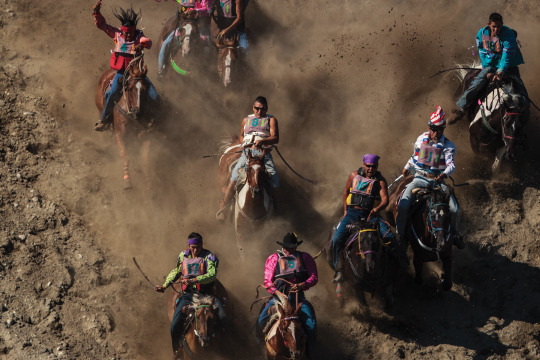
This article was written by Allison Williams, published in the August 2017 issue of Seattle Met, and reformatted here for your enjoyment.
This one is text heavy and long, so it is hidden under a read more.
Thursday
Eighteen horses form an imperfect line on a hot August night, their 18 jockeys clad in jeans. Here on a sandy bluff in the small town of Omak, four hours east of Seattle and several worlds away, riders and spectators alike move with nervous energy, anxious for the race to start. One jockey wears a helmet topped with a pink mohawk, another with a GoPro camera. One horse, sponsored by a local marijuana dispensary, sports painted pot leaves on its rump. Wispy white eagle feathers hang from others, emblems of the Native American heritage the men share.
A summer carnival glows below, neon outlines of rides called the Orbiter and the Fireball, metal towers that came into town on tractor trailers. Farther into the Okanogan Highlands, a casino twinkles alone on Indian Reservation land. It’s August 11, 2016, and even an hour past sunset the air holds onto most of the heat from the 90-degree day.
A “whoooop!” erupts from the gathered crowd as the animals sidestep and bob their heads behind the chalk starting line. His race number bright across his chest, 18-year-old Scott Abrahamson eyes the sandy dirt in front of the line, groomed like a golf course sand trap. His long bubblegum-pink sleeves mean he’s easy to spot even in the shadows where floodlights don’t reach, and his helmet blinks with battery-operated toy devil horns. He’s surrounded by both champions—Loren Marchand with seven titles, Tyler Peasley with three—and nervous high schoolers in their first race.
At the crack of a gun, the horses charge. Their riders lean forward as hooves pound the sandy flat, at least for the first hundred feet. The crowd cheers as soon as the pistol sounds, cries and hoots blossoming into the dark.
Then 18 horses go off a cliff.
The riders shift in their saddles as their mounts fly down an incline steeper than a ski jump. The best jockeys, the veterans, barely lean back coming off the hill, reins clasped in the left hand and riding crops in the right. Others grasp a bar they’ve rigged on the back of their saddles they call the “oh shit handle.”
The spectators’ cries reach full pitch when the pack is halfway to the waterway at the base of the hill, a thick ribbon of black that flows left to right. The horses plunge into the inky Okanogan River en masse, hooves hitting the shallow bottom, and all but one charge across to the opposite bank. The stadium on the far side is lit up like a Friday-night football game, floodlights bright atop red, white, and blue bleachers, and Scott and his hot-pink sleeves emerge first in the dirt oval, just 45 seconds into the race. As they cross the finish line, Peasley is right on his tail.
Fifteen horses follow, minus the one that tumbled in the river. A crew attends to the downed horse from the deck of a small drift boat; while the stadium roars, a veterinarian surveys the animal and notes that it’s already gone, likely drowned.
Back atop the hill, Colville tribal elders watch through binoculars before one spots something in the sandy dirt, an eagle feather dislodged by the chaos. They circle the downed quill, addressing the spirit it represents, the eagle that travels in both worlds, before one of the elders lifts the feather to return it to its owner.
This is the World Famous Suicide Race.
There will be four races total during Omak Stampede, always the second weekend in August. Each race awards five points to the first-place finisher, four to the second, and so on; the overall winner clinches the King of the Hill title on Sunday, and $40,000 in prize money is distributed. It’s the highlight of this Central Washington town’s year, a tradition that draws thousands of spectators—and animal-rights protesters.
Omak straddles the border of the Colville Reservation, home of almost every racer, horse owner, and trainer. The contest is a rite of passage, they say, a proving ground for men—and even a few women—coming of age more than a century after actual horseback warfare. Beyond the turgid flow of the Okanogan River through town, the reservation sprawls over 1.4 million acres of highlands, brittle with brown grass in late summer. There the Native American communities are plagued by poverty and unemployment.
If the Suicide Race was a small-town Friday-night football game, teenaged Scott Abrahamson would be its star quarterback. He’s an ace student, focused and polite, with technical internships and honor rolls to his name, but this weekend he’s a jockey with a King of the Hill title to defend. All eyes are on him.

Friday
He gets sick before every big race. “Everything hits me and my body,” Scott says. “I can barely walk.” His cousin calls it good luck; Scotty puking means they’re going to do well.
In the hours before Friday’s race, the second of four, Scott’s prepping in the triangular Owners and Jockey’s paddock in the middle of the fairgrounds. By 5pm, Omak veterinarian Jai Tuttle holds court at one end of the dusty enclosure, near standing fans that muster a little manufactured breeze. As they wait to parade their horses for Doc Tuttle, owners angle water hoses over the animals’ backs.
Everyone older than Scott calls him Scotty. This year’s printed program, in the roster of winners dating back to 1935, calls him that. After he won in 2015, he became small-town famous, no longer just the good kid who excelled at basketball and wrestling. People holler, “Go Scotty” at him all weekend.
His father was famous too. That’s what happens when you win the Suicide Race; Leroy Abrahamson took the title in 2002, but was best known for his prowess in the Indian Relay, a more widespread style of racing where one jockey hops from horse to horse. Leroy, Scott has heard, would flit from one mount to the next with only a single foot brushing the ground.
Scott doesn’t remember his first time in a saddle but assumes it was before he could walk, though he largely gave it up in elementary school, when his parents split. His father was the horse guy; his mother was all about school. So he became a standout student in Coulee Dam, a reservation town in the shadow of the 50-story hydroelectric giant. When his father died in 2009, he was drawn back to horses.
“I’m sorta doing all this for him,” Scott says, hesitant. His mother wasn’t wild about the racing, but he didn’t falter at school, scoring an engineering internship with the Bureau of Reclamation. Slight and muscular, his five-foot-nine stature is too tall for a throughbred jockey but about average for this race. His hair is short and straight, spiking around his head like a halo, and he likes to hide his eyes behind sunglasses.
The summer he was 16, after his sophomore year of high school, Scott entered his first Suicide Race. Atop a small gelding named Kinky, he fell as they crested the top of the hill on the Thursday race, flipping over the horse’s shoulder. On Friday the pair wrecked in the water.
“I flipped over and everybody ran me over,” he says. “Everyone says it happens so fast, but when I was in it, it was like slow motion.” Finally, on Saturday, they made it through the entire race, galloping past the finish line in the stadium. Then Sunday the pair wrecked again.
A new horse was in order. His trainer, George Marchand, is a giant within the Suicide Race world and holder of three titles. He’d lost his own father at 14 and rode against Leroy Abrahamson 15 years ago, so he guided Scott, this time to a nighttime ride on a quarter horse–thoroughbred mix named Eagle Boy. The butterscotch-colored gelding was only about five years younger than the rider.
“It was pitch black and dusty,” remembers Scott. The hills of the reservation are dotted with brush and ponderosa pine, but he could make out little from his saddle. They were on top of a hill, he knew that, and that George had taken off.
He gave Eagle Boy his head as they sped over the uneven terrain. “We were jumping trees and dodging trees,” recalls Scott, but they moved as a unit. “I was like dang—he trusts me.” Matching horse to rider is alchemy.
In 2015, in his second year racing and only 17 years old, Scott on Eagle Boy tied for first overall with six-time victor Loren Marchand, George’s nephew. With a wide grin stretched across his face, the rising high school senior played rock-paper-scissors with his cochamp for a King of the Hill prize bridle.
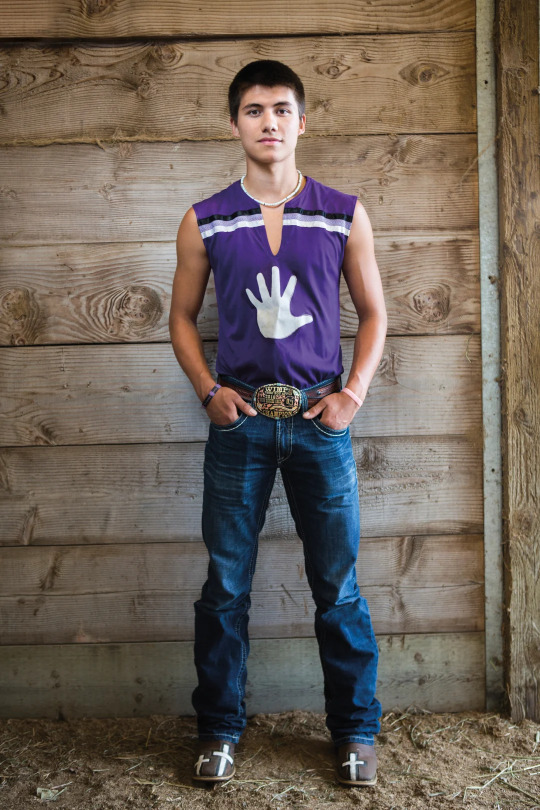
The name World Famous Suicide Race might be a bit of hyperbole, but the race is nothing if not infamous. It emerged in scrappy Omak where a Great Depression population boom—all the way to 2,500 souls—launched an annual rodeo in 1933. As publicity chairman, furniture store owner Claire Pentz proposed a dramatic steeplechase to draw spectators, inspired by mountain races across the reservation at Keller, where riders charged a dry channel in the Sanpoil River. He knew how to sell it: He gave his 1935 creation a catchy name.
The World Famous Suicide Race ran every summer, the marquee event at the four-day Omak Stampede rodeo. Dynasties were born when the inaugural race’s third-place finisher, Alex Dick, won regularly through 1965. There have been seven Marchand riders over the years, six Abrahamsons, nearly a dozen named Pakootas. The unofficial motto, one that appears on winners’ belt buckles, is “Wimps Need Not Apply.”
The 210-foot hill, most say, is a 62-degree slope. Or it’s 54.7 degrees, as measured by a race official in 1993. Others say it’s more like 30. Regardless, it’s terrifying. From the top, the hill feels as steep as a hard ski run; a black diamond, but not a double black. Scrambling up on foot, you might use your hands.

The stampede and race remain intertwined, but in 1999 the Colville Tribes boycotted to protest a change to their camping space on the fairgrounds. The Stampede lost attendance and revenue, and the following year a deal was struck: The tribes got more control over the race organization, and the encampment got its park space.
Family ties bind many of the owners, trainers, and jockeys, and while a few aren’t Native American at all, they’re the exception. This is the biggest sporting event in the region, the Super Bowl of north-central Washington. “This is the only time we get to play cowboys and Indians,” jokes one organizer, Ernie Williams.
Doc Tuttle is fairly new to the race gig, but between her ease with fidgety horses and no-nonsense demeanor, the veterinarian exudes authority. One by one she clears the horses for Friday’s race, directing owners to walk each thousand-pound animal in a figure eight as her eyes stay trained on forelegs and haunches, scrutinizing for swollen tendons or joints.
No one can pretend the Suicide Race isn’t controversial. As early as 1939, the protests started; Humane Society president Glen McLeod succeeded in canceling a mountain race in nearby Hunters, then traveled to Omak and Keller hoping to do the same. “Why, even the riders call it a ‘suicide race,’ ” McLeod told The Seattle Daily Times before a similar trip in 1941.
Animal rights groups started keeping a tally of dead horses in 1983, with one count now at 22. “The reality is that the race is viewed as part of the Omak Stampede rodeo, and rodeos are protected under state law,” says Seattle Humane Society spokesman Dan Paul, but points out that rapid shifts in public sentiment swiftly made SeaWorld orca shows and circus elephant acts extinct.
People for Ethical Treatment of Animals has run letter-writing campaigns. In 1993, the Northwest’s PAWS, or Progressive Animal Welfare Society, tried a more robust tactic, filing a lawsuit that alleged organizers harm horses for profit, but a Superior Court judge threw out the case. In 1996, a PAWS member sued the Okanogan County Sheriff’s Office and the rodeo for roughing him up when he videotaped a horse being euthanized; the suit settled for $64,500.
For the organizers, the response is simple: The race is merely an extension of their horse-infused culture. Every rider points out that they ride similar hills during wild-horse roundups and cattle work.
Horses have to pass three checks before they’re allowed entry into the race: the vet examination, a swim test, and what’s called a hill test, where horses must round the top of Suicide Hill without hesitation.
Tuttle isn’t from the reservation; she isn’t originally from Omak. But even as an outsider, the one who has to put horses down if they’re hurt, she doesn’t think it’s inhumane.
“These guys use horses that love it,” she says; the horses are bred to it and run steep hills regularly on the remote corners of the reservation. She rarely has to disqualify a horse because owners who spot lameness usually scratch. “It does hold a real special place in the Native culture. It does.” And that horse Thursday night that likely drowned? She considers it. “He was doing what he loved and he had a quick and honorable death.”
Friday night’s race is classic and clean; no bad wrecks. As always, the riders reach the starting line by crossing the river on the Highway 97 bridge, closed to traffic. Hooves clomp on the asphalt as the parade passes a road sign that reads, “Tribal Code Laws Apply.” There are no rules to apply in the Suicide Race once the gun is fired; riders can whip each other, pull each other’s reins. No helmets required. No wimps.
The results echo the previous night: Scott Abrahamson and Eagle Boy come in first, Tyler Peasley on Spade in second. When Scott wins, he raises his right hand above his head, palm out, fingers outstretched. His father’s gesture.
Scott was only four when Leroy won the Suicide Race. “Everyone said he was one of the greats,” he says. “It’s kinda hard to fill his shoes.” Instead he fills his horns. He wears Leroy’s blinking red devil headpiece, the kind of bauble most 18-year-olds would don at a Halloween party.
Scott’s idols were the riders who won in the late 2000s, including the 30-year-old three-time champion who came in second to him during this weekend’s first two races. As a kid he’d run down hills playing at Suicide Race, imaginary whip flying, yelling, “I’m Tyler Peasley!” After his 2015 win, Scott noticed something: “The kids run around saying they’re me.”
It’s after 10pm when the racehorses have completed their cooldown laps and have been loaded into trailers for the ride home. Scott accompanies George Marchand to Omak Lake, 15 miles out of town, to let Eagle Boy soak before bed.
Saturday
Saturday night’s Suicide Race is the biggest. The 7,700-seat arena is packed, and lines form at every fun house and stomach-destroying ride in the carnival outside. Booths hawk curly fries, cotton candy, and foot-longs, though the longest lines are reliably at a taco truck.
But that’s not the whole Omak Stampede. On the east side of the arena, a mirror festival, maybe even larger: the Indian Encampment. Rows of teepees surround a round pavilion for dancing and drum performances, with RVs and tents beyond that. Spectators bring their own camp chairs to supplement the few bleachers. Booths sell jewelry, T-shirts, and dream catchers, and while some of the food is the same—nothing is as universal as curly fries—more signs are handwritten, and many vend Indian tacos and huckleberry lemonade.
Before the rodeo begins, the arena’s industrial speakers blast pop country songs over every acre. The festivities begin with a series of anthems and processions, recognizing the neighboring nations of Canada and the Colville Tribes. During the ride-in, dozens of rodeo queens from around the West shoot into the center oval on horseback, one by one, decked in every shade of sparkle.
The announcer introduces each event, then banters with the rodeo clown when things get slow or a bull rider needs a moment to limp off the dirt. The Professional Rodeo Cowboys Association produces the classic rodeo events, ones with more white riders than Native: bull riding, steer wrestling, team roping, barrel racing. Specialty acts bridge the competitive sports: trick riders and one blonde woman who does a kind of partner dance with an unbridled palomino horse to the blaring sounds of a country song called “Free.” It ends with the horse placing its blond head in her lap.
The Suicide Race is the final blockbuster event. Spectators wade up to their knees into the Okanogan River just upstream of the race crossing, bare feet on slimy rocks. Signs still note that video recording is prohibited, but they’re roundly ignored in the age of cell phones.
Despite the shocking name, the only rider death since anyone’s kept close records was one who drowned on his way to the starting line—though there are plenty of close calls. In 2002, the year Leroy Abrahamson took home the title, racer Naomie Peasley took a tumble so bad she fractured her skull. She recovered, but not before flatlining twice in the medic helicopter.
In its anti–Suicide Race materials, PAWS airs a common criticism of the race: its authenticity. “Organizers currently contend that the Suicide Race has roots in Native American tradition but, in fact, an Anglo conceived the race as a publicity stunt,” reads its statement. Detractors hang on that detail, its origins with furniture salesman Claire Pentz.
To riders and trainers, though, Pentz is irrelevant, and they point to the deep roots of horse culture. For Scott, the point of the race is clear: “Showing that a young man is becoming a warrior, becoming a man.”
The race, the encampment—it’s the tribes’ biggest invitation into their world. “There’s more that people don’t see behind these walls, about Indian life...sweat lodges, medicine,” adds Aaron Carden, a retired racer who now teaches Native language on the reservation. Of the borders around that world, he says, “It’s not our fence to keep people out. It’s the fence white men built to keep us out of the area they took.”
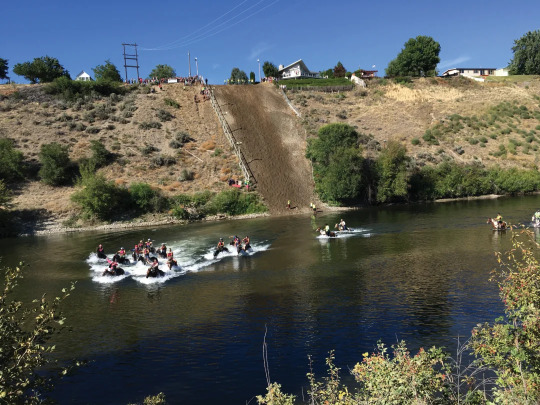
The race wasn’t the only thing “created” by a white man; the very invention of a Colville Tribes unit is recent. Long before that, before statehood, before Manifest Destiny, before Lewis and Clark white-privileged their way across the American West, the Okanogan Highlands tribes lived nomadic lives, picking berries and drawing salmon from the massive Columbia River. And racing horses.
First came the incorporation of Washington Territory, then a series of executive orders begun by president Ulysses S. Grant that roped several tribes into three million acres between the Methow Valley and the Columbia River. Others were elbowed into the reservation, linking bands that once stretched from the dusty plains of Washington to the mountains of British Columbia. One chief invited a famous Indian leader, Chief Joseph, and his Nez Perce followers in 1885. With his band, the Confederated Tribes of the Colville Reservation—a patchwork assembly that had no single language or traditional commonality—reached their current 12-tribe size.
Over 125 years the tribes faced what so many other American Indians did—children forced into boarding schools, languages squashed. The federal government forced a cheap buyback of 1.5 million acres, lands still lamented as the lost “North Half.” The Grand Coulee Dam, erected in 1942, blocked spawning salmon with its 550-foot concrete walls; Colville tribal members mourned the loss of Kettle Falls, a historic fishing spot, with a Ceremony of Tears before it was submerged by the dam’s backup.
In the 1960s, the tribes toyed with termination, dissolving the reservation altogether and splitting the lands among its 5,000 members. Reservations had been terminated by the government before, but the Colvilles were the only ones to dare seriously consider it themselves, an unprecedented move of self-governance. Congressional hearings were held but the measure never passed, so the Colville Reservation endured.
The Suicide Race is a separate world from suicide itself, a public health crisis for the Colvilles. Whether spurred by pervasive poverty—reservation unemployment topped 50 percent in 2010—or rampant substance abuse, the suicide rate ballooned to 20 times the national average in 2006. “After that we were in a panic on what we need to do and could do,” says tribal staffer Olivia Wynecoop. Tribal leadership declared a state of emergency, and Wynecoop helped secure grants for education and designating “natural helpers” to be on call for suicide emergencies.
Scott positions Eagle Boy at the western end of the starting line for the Saturday-night race. This isn’t like the starting gate at the Kentucky Derby; horses pace and turn, and the antsy palomino next to him does a sideways prance before the starter pistol goes off. Scott is angry, though later he says he can’t remember why. Trash talk and psych-outs are regular along the starting line, older jockeys trying to ruffle the young ones still gathering their courage.
But three years and one win into the Suicide Race, Scott can ignore the chatter. He and Eagle Boy are still until the gun sounds, then fast to the crest of the hill. Aaron Carden still remembers the feeling 25 years after his first win: “You’re actually flying in the sky. Nobody can take that away from you.”
There’s a commotion, a cloud of dust to Scott’s left, but he’s well in front of the pack as they hit the water. Two strides into the dark water, Eagle Boy stumbles, flinging Scott into the river. His blinking red devil horns disappear under the white churn created by horses on either side. They’re both okay but don’t log a finish.
What Scott couldn’t see was what happened on the top of the hill, to the very first rider off the break. Tyler Peasley, whom Scott idolized as a kid, and who’d placed at Scott’s heels the past two nights, darted off the top of the hill like a raptor after its prey. Peasley’s a little taller than Scott, broader shouldered, and he rides to win. His mount, Spade, got so much air he tucked his back legs underneath him and simply sailed for the first 30 feet of the downward slope.
They were serene in that moment, flying, until Spade’s hooves finally hit the tilted ground again; Peasley pitched over Spade’s front left shoulder before the horse executed a tight somersault. The jockey disappeared under the hooves of the horses behind him and the crowd made a collective, guttural gasp. Peasley’s body didn’t come to a stop until he reached the bottom of the hill.
Sunday
The final race is also the only daytime race of the weekend; for the first time since the trials and runoff races held before the stampede, they’ll be rushing the hill in full daylight.
The mood in the O&J paddock is subdued, but word is going around that Peasley is stable at a nearby hospital. News will later spread that his injuries included a broken pelvis, hip, and ribs, and the racing community fundraises to support his care and gas money for his family to visit him.
Remarkably, Tyler’s horse, Spade, is unhurt from the tumble, ready to race again. His owner lights a bundle of sage and says a few words over the horse before a new jockey takes the saddle.
For the final time in 2016, Scott follows the parade to the top of Suicide Hill. His jeans have a gaping hole in the knee—real wear from hard riding, not a fashion statement—and his wraparound sunglasses are ’80s big. No devil horns for the daytime race, but, as ever, his name is the one most shouted by the crowds: “Come on Scotty,” over and over.
With 10 points already earned, Scott only needs to place to secure the title. Owner and trainer Marchand tells him not to go all out, and when the gun fires, he doesn’t. He holds back his whip, lets Eagle Boy run the race without extra urging. It’s the smart move, the calculated move, no doubt informed by the disastrous night before. But Scott comes to regret holding back.
Not because it doesn’t work. Scott and Eagle Boy place second, netting four more points and easily clinching his first solo all-around title. But for Scott, the kind of driven athlete who hates to give a single inch, playing it safe feels wrong. Now with two titles to his name, only three years in, he says he’ll ride “until I get broken down and can’t do it no more.”
Three days later, Scott will depart his Coulee Dam home and drive five hours to start his freshman year at Washington State University. As an engineering student he will pull a 3.8 GPA his first semester and a 3.9 the second; he’s lined up two years of scholarships so far and hopes he’ll be able to extend to the full undergrad four.
Scott won’t brag about his Suicide win at college, but he’ll drive home every fall weekend for Indian Relay races, another sport that mixes horsemanship with a touch of anarchy. Around the reservation, he doesn’t have to brag about being King of the Hill; everyone already knows. “He’s the Steph Curry of the Suicide Race,” one tribal member says. “Loren and Tyler are the Lebrons.”

The second weekend of August 2017 is already on everyone’s calendar. Scott will be back on Eagle Boy, who he now half owns with George Marchand—a 49 percent share. He now has a streak to defend. By early June, high winter snows have melted to fill the Okanogan River, and ecologists are warning of water flows two or three times normal. Scott guesses that, with the river this high, it’ll be too deep for the horses to simply wade across during the Suicide Race; they’ll have to swim for the first time since, he believes, 2002. The year his father won it all.
But on Sunday night in August 2016, after the King of the Hill awards and the pictures, he’s just a high school kid again. He wanders the Indian Encampment with friends, waits in line for fry bread.
Under the pavilion, dancers spin and step, decked in elaborate feathered headdresses and beaded robes. Some have numbers pinned to their costumes, like marathon runners, to compete. In a drum tent, the songs are a steady thrum of chants and cries, indecipherable to the visitors who stand awkwardly outside the rows of seated tribal members who are at once both audience and participant.
Picture this: a quiet mountain lake, bordered by rocky hills dotted with ponderosa pine. In daytime Omak Lake is seven miles of brilliant turquoise, but now, at night, it’s a black mirror. Two men drive a horse trailer to its shore, unloading an unsaddled Eagle Boy.
It’s one of George Marchand’s secrets to success; the lake minerals soothe the bumps and scrapes along the horse’s legs. In the midst of the annual Perseid meteor shower, the uncloudy Okanogan skies are perfect for spotting streaks of celestial light, but the men don’t look up as they dissect the day’s race.
Scott holds Eagle Boy’s halter from a dock while the horse wades into the water, breaking the lake’s calm. The water hasn’t yet cooled from baking under another 90-plus degree day, and the hills that round the lake keep the night air still. They’ve survived another madcap contest together, earned another W. They’re back on the reservation, back home. In the silence the only sound is the lapping of the lake water against a horse.
#horse racing#rodeo#native american#indian#horseblr#horse news#mine#omak stampede#the world famous suicide race
33 notes
·
View notes
Photo
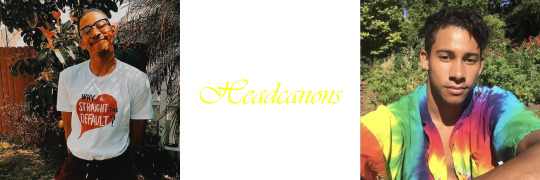
Task: Headcanon Countdown
5 Headcanons About: Appearance
August’s hair is constantly changing. When he was younger, he always kept it short and never dyed it, but once he reached his 20′s, he began experimenting with his hairstyles and colors. He often finds himself returning to the buzzed look, but when he does, he’ll dye it a funky color, despite his father’s objections. His favorite color that he’s done is the rainbow that he did for 2021 pride.
August has one tattoo of a key on his wrist. He got the tattoo on his 23rd birthday. He decided to get this tattoo in this specific design for two reasons. The first reason is that he loves the symbolism of the key– unlocking doors throughout his journey of self-discovery and self-fulfillment. The second reason is that people always told him growing up that he “wore his heart on his sleeve,” so he decided to show that to the world through art. He’s considered getting other tattoos, but hasn’t figured out what he wants yet.
August got his ears pierced in his sophomore year of high school. He usually goes for a fake diamond stud earring, but will occasionally choose a dangle earring. In terms of jewelry, he also enjoys necklaces, but will only wear them for special occasions.
August can often be found wearing bright colors, especially in the summer. His favorite color is yellow, so he tries to incorporate it into his style as much as possible. During the summer, he can often be found in some sort of tie-dye clothing. During the winter, he likes accessorizing with bomber jackets and army jackets.
August was a small, scrawny kid, but through dancing, swimming, and other forms of exercise, he has developed an athletic build. Even though he isn’t dancing professionally at the moment, he still practices on a weekly basis. Additionally, he swims in the ocean whenever he
4 Headcanons About: Travel
August has paternal relatives in Canada, England, France, and Nigeria. He has only visited his family in Nigeria twice in his life, but would like to go back some time in the near future. He’s never been to France or Canada, but has visited his aunt in England a few times.
For his 8th birthday, August’s aunt Obongoawan flew him and his family out to Manchester, England, to visit her. She bought them all first-class tickets, and this was the first and only time the Emmanuels flew first class. First-class flying wasn’t all it was cracked up to be, and Oduva felt guilty that Obongoawan spent all of the extra money on them, so he told her not to do that again. Nevertheless, she still insists on buying their tickets every time they visit her.
August was apart of a traveling dance troupe from 2018 to 2021. Through the group, he participated in two full tours around the entire country. His favorite cities were Chicago, Seattle, New York, Portland, and Orlando. He loves his home state of California, but if he had to settle down anywhere else, these cities would be his top 5 choices.
There are several countries August would like to visit once he’s older and has more money. Firstly, he would like to visit his family in France and Canada. Secondly, he would like to visit Ireland and Denmark as a means of connecting with his mom’s roots. Lastly, he would like to visit Australia because he thinks it would be a fun trip to make.
3 Headcanons About: Ethnicity
August’s father, Oduva, is ethnically Nigerian. Oduva was born and raised in Kano, Nigeria, but his ancestors are from Edo State. Oduva moved to the United States at age 17 in order to attend business classes at UCLA.
August’s mother, Dawn, is ethnically Irish and Danish. August’s maternal grandfather immigrated to the United States from Ireland in 1960 at the age of 20. August’s maternal grandmother was born and raised in Sacramento, California; her family has lived in the United States since the 1880′s.
When asked, August will proudly share his ethnic background. However, much to his shame, he doesn’t know any of the native languages of his ancestors. However, he hasn’t found anyone willing to teach him any of these languages. The only language other than English that he (somewhat) knows is Spanish because he took classes in high school and college.
2 Headcanons About: Workplace
August is currently working as the assistant manager at Healing Herbs Dispensary, the dispensary owned and operated by his parents. After medical marijuana became legal in the state of California, Dawn and Oduva Emmanuel saw an opportunity and took it. They embarked on a few small business ventures before opening Healing Herbs, but none of them lasted very long. After the legalization of recreational marijuana, they had a boom in business.
When August is working, he’s always puts music on. The store has an iPad that uses to play songs from Spotify. When there are no customers in the store, he can often be found singing and dancing around the store as he does his cleaning tasks. People often walk in on him performing to no one, but no one has ever been rude or discouraging about it.
1 Headcanon About: Defining Moment
For August, the moment in his life he considers to be his “defining moment” is when he left home in January 2018 to be in the dance troupe. This was the first time he had ventured out into the world on his own. He was nervous, but he knew it needed to happen. It was his first step into the world of professional dancing, and he loved every minute of it. As much as he loves spending time with his family again, he wants to go back to dancing as soon as he can; for now, however, his parents need him in the store.
2 notes
·
View notes
Text
How One Woman Changed the Coffee Industry
Note: last year, I was invited to contribute a piece on the ‘second wave’ of coffee to the Deutsches Museum’s exhibit ‘Cosmos Coffee’. The following is the text of my contribution. Many thanks to exhibit curator Sara Marquart for the invitation.
* * *
In 1968, a professional secretary named Erna Knutsen took a job in a coffee trading firm in San Francisco. Part of her job was to maintain the “position book” in which accounting records were kept concerning the company’s coffee inventory and contracts with BC Ireland, a well-established coffee importer. Although born in Norway, Knutsen had grown up in New York City, a place where––like the rest of America––coffee had become the definitive everyday drink: ubiquitous, commonplace, ordinary. Though coffee’s origins are in Africa and the Middle East, and early European and American coffee drinkers recognized the deep cultural roots and special flavor of coffee, by the mid-twentieth century American enterprise had tamed the exotic coffeehouse and sanitized the smoky, brash coffee roasting companies. Coffee had become slick big business and, by the 1950s, coffee was a quotidian drink for most Americans, a commodity sold pre-ground in cans lining the shelves of polished, sterile “supermarkets.”
By the late 1960s, coffee was in trouble. Per capita coffee consumption had fallen steadily since the end of World War II and young people were rejecting sanitized commercial coffee brands as boring, tasteless, and square. Slowly, in the latter half of the 1960s, a different vision of coffee began to emerge in cities on the West Coast of the United States. Alfred Peet, an immigrant from the Netherlands whose father used to run a coffee roasting company in Europe, had worked in America’s coffee industry and found it lacking in quality and variety. He established Peet’s Coffee, Tea, and Spice in Berkeley in 1966. His shop liberated coffee from its steel cans and sold whole beans, scooped from gleaming brass bins into simple paper bags, alongside exotic teas and spices. Decorated with wood paneling and vintage coffee equipment, Peet’s evoked a nineteenth-century coffee aesthetic and was a rejection of the space-age modernism of the 1960s supermarket.
Soon, Peet was joined by others: in 1968 in San Diego, Bob Sinclair founded Pannikin Coffee Tea and Spice, which sold freshly roasted coffee alongside handmade cookware. That same year, after honeymooning in Sweden and experiencing a coffee epiphany, Herbert Hyman opened his first coffee store in Los Angeles, called the Coffee Bean. In 1971, Jerry Baldwin, Zev Siegl, and Gordon Bowker, three friends who met at the University of San Francisco and who were inspired by Peet’s vision of coffee, founded Starbucks in the city of Seattle, naming the company after a character in Hermann Melville’s classic novel Moby Dick. In 1972, Carl Diedrich, a German immigrant who arrived in the United States via Guatemala, established his own coffee company in Costa Mesa, California. George Howell, also inspired by Peet’s in Berkeley, brought the vision to Boston, founding the Coffee Connection in 1974. Before long, most urban metropolitan areas in the United States had their own small coffee company, dedicated to a common vision of quality coffee and freshness.
From her secretary’s desk, Erna Knutsen could see something unique was happening. These new, young, quality-oriented coffee companies were asking her for “special coffees.” They insisted on the very best quality, seeking out unusual varieties, historic origins, and meticulously prepared “lots.” Realizing that her bosses at the coffee trading firm thought of these new coffee companies as an annoyance, Knutsen began to focus on identifying these special coffees and presenting them to her audience of small, quality-oriented coffee companies, building a little side business. It was in an article she wrote for the Tea and Coffee Trade Journal in 1974 that she called this new market segment “specialty coffee.” In building her business and documenting the rise of a new generation of coffee companies, Knutsen was one of the first to identify what we now call the second wave of coffee––a group of coffee entrepreneurs who, in rejecting the norms of the commodity coffee business of the mid-twentieth century, created an aesthetic and a movement of their own.
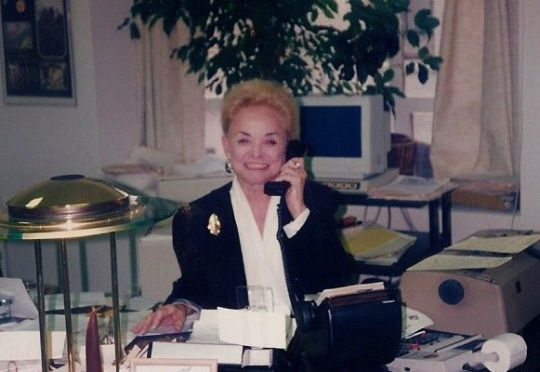
Erna Knutsen at her desk.
The specialty coffee era emerged as America rediscovered gastronomy. Led by culinary enthusiasts like Julia Child and Craig Claiborne, a new movement helped Americans discover the regional cuisines of Europe, explore the ethnic diversity of food in the United States, and partake in the excitement of exploring food traditions from around the globe. In 1968, Child’s television show The French Chef was at the peak of its popularity, introducing Americans to the techniques and traditions of French cooking. New York Times food editor Craig Claiborne’s Kitchen Primer was published in 1972, introducing his readers to French, Italian, and Spanish cooking techniques, complete with instructions on brewing fresh coffee. This aesthetic of culinary technique, gastronomic exploration, and a do-it-yourself ethos created a fertile environment for entrepreneurs with a zeal for coffee, flavor, and cuisine. It should be remembered that many of these coffee companies sold spices, cookware, and books alongside coffee. This meant that coffee became central to a lifestyle that embraced good food and drink and the desire to cook “the hard way,” and eschewed the conveniences of frozen-food dinners and pre-ground coffee.
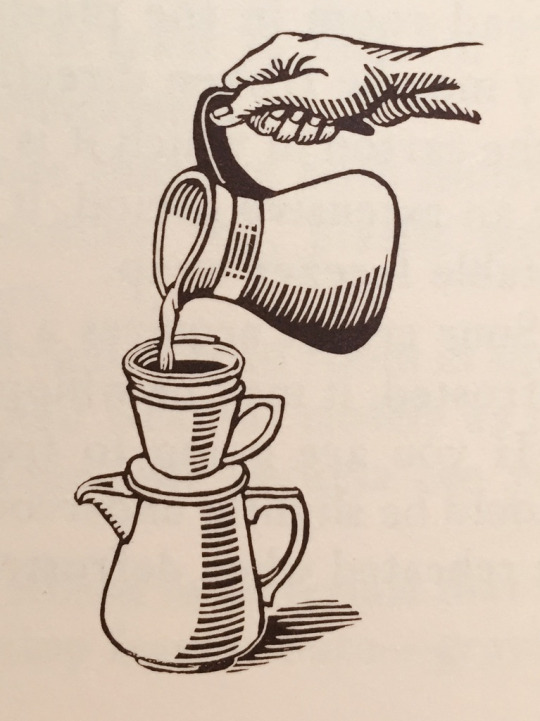
detail of coffee brewing in Craig Claiborne’s “Kitchen Primer” by illustrator Tom Funk, 1972
The second wave of coffee went hand-in-hand with a new sense of cultural exploration. The 1960s and 1970s were an era characterized by ethnic identity and pride, and specialty coffee companies incorporated cultural awareness – particularly of Latin America and the Pacific Rim––into their own identities. Royal Coffee and Knutsen herself sang the praises of Mandheling coffees from Indonesia, George Howell celebrated Huichol art, Pannikin integrated Mexican chocolate and indigenous Mesoamerican folkways into its company identity. All this exemplified these companies’ attempts to communicate and celebrate the cultures from which coffee was sourced. “Offering sheets” and newsletters from coffee importers circulated by post and by fax in the pre-internet era provided a critical education in the coffee trade to the widely-scattered companies of the second wave. Erna Knutsen’s missives, enthusing about the qualities of the coffees she traded, became legendary, as did updates from Royal Coffee and others. Second wave roasting companies from this period embraced the offering sheets aesthetic of the coffee importers and began to expose consumers to the language of the coffee trade, adding regional names like Guatemala Antigua and Ethiopia Harrar to coffee menus, alongside technical trading terms like “Kenya AA” and “Colombia Supremo.”
All of this was done in a spirit of cultural rebellion. Taking their cues from the back-to-the-land and bohemian movements of the late 1960s, second wave coffee companies embraced a style of rebelliousness and nonconformist business practices that came to typify the movement. Bob Stiller founded the Green Mountain coffee company only after the success of his first business, “E-Z Wider,” a company that manufactured rolling papers for use in smoking marijuana and was named after the seminal counterculture film Easy Rider. Paul and Joan Katzeff founded their company Thanksgiving Coffee as a “hippie business.” Although Alfred Peet embraced a conservative personal style, his shop in Berkeley became known as a countercultural hangout, and its regulars became known as “Peetniks,” after the Beatniks.
In the 1980s, these companies began to be embraced by the wider community, having already become well known to the culinary elites and bohemian subcultures of the cities they served. Individual, idiosyncratic outposts turned into local chains of retail stores, which began to host coffeehouses too. In 1982, the Specialty Coffee Association of America was founded. Erna Knutsen helped lead the way in providing a professional association that could assist with establishing standards and educating personnel at the companies participating in the movement.
In the tradition of the second wave’s celebration of European coffee style, Howard Schultz incorporated the Italian espresso bar aesthetic in his Il Giornale project, which became an integral part of Starbucks’ identity. Second wave specialty companies became known more for their beverages than their beans, and the Italian “caffè latte” simply became a “latte”, which in turn became synonymous with specialty coffee in popular culture. The espresso bars and coffeehouses of the specialty coffee companies began to typify the movement, and became essential parts of urban and suburban communities in the 1980s and 1990s. Ray Oldenburg’s 1989 book The Great Good Place specifically focused on specialty coffee shops as important elements in American cultural life, and these second wave companies began to take their role as curators of public space more seriously.
By the 1990s, the second wave of coffee was cresting. Peet’s, Starbucks, Coffee Connection, and many others were expanding rapidly, opening new stores to meet consumers’ demand for high quality coffee beverages, specialty coffee beans, and public spaces where communities could come together. But then the coffee tradition that commenced with a counterculture identity and culinary approach began to be seen as ubiquitous and standardized, and incorporating elements of the 1950s coffee culture it was established to oppose. Coffee shops began to be regular features of suburban strip malls, specialty coffee brands began to appear in pre-ground packages on supermarket shelves, and espresso bars began appearing in gas stations and airports. This led to a great conflict within the specialty coffee movement: was its rapid expansion evidence of “selling out” and abandoning specialty coffee values, or was this a mission with a higher purpose––bringing great coffee to the masses? Were the ideals expressed in Erna Knutsen’s moniker “specialty coffees” possible in the context of mass markets and public stock offerings?
A counter-movement within specialty coffee began to form. This loose group of professional craft coffee roasters established themselves as the Roasters’ Guild, objected to the commercial excesses of the second wave and sought to build a new movement that recommitted to values of quality, freshness, and artisanship. Young entrepreneurs who had worked as baristas or roasters for the second wave companies began to establish companies of their own, seeking to reclaim the mantle of specialty coffee and create new cutting edge coffee.
Some made the transition between generations––Erna Knutsen and George Howell remained relevant to the next generation of coffee entrepreneurs even into their 70s and 80s––while other specialty coffee companies sold or folded. A new generation of specialty coffee had arrived. Trish Rothgeb identified the third wave of coffee in her influential 2003 essay “Norway and Coffee”, published in the Roasters Guild newsletter. Third wavers built upon the culinary drive, cultural exploration, and spirit of rebellion that epitomized the early specialty coffee movement, and brought those values to a new generation. And Erna Knutsen, who had ushered in the original specialty coffee revolution, was there cheering it on.
In June, 2018, Erna Knutsen passed away at the age of 96. Her passing may well mark the definitive end of the second wave of coffee, but the ideals and aspirations of the specialty coffee community live on.
18 notes
·
View notes


